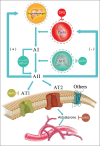Dual Blockade of the Renin-angiotensin-aldosterone System in Type 2 Diabetic Kidney Disease
- PMID: 26712437
- PMCID: PMC4797548
- DOI: 10.4103/0366-6999.172599
Dual Blockade of the Renin-angiotensin-aldosterone System in Type 2 Diabetic Kidney Disease
Abstract
Objective: To examine the efficacy and safety of dual blockade of the renin-angiotensin-aldosterone system (RAAS) among patients with type 2 diabetic kidney disease.
Data sources: We searched the major literature repositories, including the Cochrane Central Register of Controlled Trials, MEDLINE and EMBASE, for randomized clinical trials published between January 1990 and October 2015 that compared the efficacy and safety of the use of dual blockade of the RAAS versus the use of monotherapy, without applying any language restrictions. Keywords for the searches included "diabetic nephropathy," "chronic kidney disease," "chronic renal insufficiency," "diabetes mellitus," "dual therapy," "combined therapy," "dual blockade," "renin-angiotensin system," "angiotensin-converting enzyme inhibitor," "angiotensin-receptor blocker," "aldosterone blockade," "selective aldosterone blockade," "renin inhibitor," "direct renin inhibitor," "mineralocorticoid receptor blocker," etc.
Study selection: The selected articles were carefully reviewed. We excluded randomized clinical trials in which the kidney damage of patients was related to diseases other than diabetes mellitus.
Results: Combination treatment with an angiotensin-converting enzyme inhibitor supplemented by an angiotensin II receptor blocking agent is expected to provide a more complete blockade of the RAAS and a better control of hypertension. However, existing literature has presented mixed results, in particular, related to patient safety. In view of this, we conducted a comprehensive literature review in order to explain the rationale for dual blockade of the RAAS, and to discuss the pros and cons.
Conclusions: Despite the negative results of some recent large-scale studies, it may be immature to declare that the dual blockade is a failure because of the complex nature of the RAAS surrounding its diversified functions and utility. Further trials are warranted to study the combination therapy as an evidence-based practice.
Figures

Similar articles
-
Efficacy and Safety of Dual Blockade of the Renin-Angiotensin-Aldosterone System in Diabetic Kidney Disease: A Meta-Analysis.Am J Cardiovasc Drugs. 2019 Jun;19(3):259-286. doi: 10.1007/s40256-018-00321-5. Am J Cardiovasc Drugs. 2019. PMID: 30737754
-
Is there benefit in dual renin-angiotensin-aldosterone system blockade? No, yes and maybe: a guide for the perplexed.Diab Vasc Dis Res. 2013 May;10(3):193-201. doi: 10.1177/1479164112463710. Epub 2013 Jan 24. Diab Vasc Dis Res. 2013. PMID: 23349369 Review.
-
Resistant Hypertension On Treatment (ResHypOT): sequential nephron blockade compared to dual blockade of the renin-angiotensin-aldosterone system plus bisoprolol in the treatment of resistant arterial hypertension - study protocol for a randomized controlled trial.Trials. 2018 Feb 12;19(1):101. doi: 10.1186/s13063-017-2343-3. Trials. 2018. PMID: 29433578 Free PMC article.
-
Dual blockade of the renin-angiotensin-aldosterone system in diabetic nephropathy: the role of aldosterone.Horm Metab Res. 2005 Apr;37 Suppl 1:4-8. doi: 10.1055/s-2005-861359. Horm Metab Res. 2005. PMID: 15918104 Clinical Trial.
-
Renoprotection by blockade of the renin-angiotensin-aldosterone system in diabetic and non-diabetic chronic kidney disease. Specific involvement of intra-renal angiotensin-converting enzyme activity in therapy resistance?Minerva Med. 2004 Oct;95(5):395-409. Minerva Med. 2004. PMID: 15467515 Review.
Cited by
-
Efficacy and Safety of Niaoduqing Particles for Delaying Moderate-to-severe Renal Dysfunction: A Randomized, Double-blind, Placebo-controlled, Multicenter Clinical Study.Chin Med J (Engl). 2017 Oct 20;130(20):2402-2409. doi: 10.4103/0366-6999.216407. Chin Med J (Engl). 2017. PMID: 29052559 Free PMC article. Clinical Trial.
-
Prevalence of Non Alcoholic Fatty Liver Disease and its Association with Diabetic Nephropathy in Patients with Type 2 Diabetes Mellitus.J Clin Diagn Res. 2017 May;11(5):OC04-OC07. doi: 10.7860/JCDR/2017/25931.9823. Epub 2017 May 1. J Clin Diagn Res. 2017. PMID: 28658824 Free PMC article.
-
Hypertension, C Reactive Protein and Metabolic Profile: What is the Scenario in Patients Undergoing Arteriography?J Clin Diagn Res. 2017 Aug;11(8):BC19-BC23. doi: 10.7860/JCDR/2017/26595.10456. Epub 2017 Aug 1. J Clin Diagn Res. 2017. PMID: 28969113 Free PMC article.
-
ISN Forefronts Symposium 2015: Nuclear Receptors and Diabetic Nephropathy.Kidney Int Rep. 2016 Sep;1(3):177-188. doi: 10.1016/j.ekir.2016.07.007. Epub 2016 Aug 5. Kidney Int Rep. 2016. PMID: 28932823 Free PMC article.
References
-
- Shaw JE, Sicree RA, Zimmet PZ. Global estimates of the prevalence of diabetes for 2010 and 2030. Diabetes Res Clin Pract. 2010;87:4–14. doi: 10.1016/j.diabres.2009.10.007. - PubMed
-
- Xu Y, Wang L, He J, Bi Y, Li M, Wang T, et al. Prevalence and control of diabetes in Chinese adults. JAMA. 2013;310:948–59. doi: 10.1001/jama.2013.168118. - PubMed
-
- Shrishrimal K, Hart P, Michota F. Managing diabetes in hemodialysis patients: Observations and recommendations. Cleve Clin J Med. 2009;76:649–55. doi: 10.3949/ccjm.76a.09054. - PubMed
-
- Hunsicker LG, Adler S, Caggiula A, England BK, Greene T, Kusek JW, et al. Predictors of the progression of renal disease in the Modification of Diet in Renal Disease Study. Kidney Int. 1997;51:1908–19. doi: 10.1038/ki.1997.260. - PubMed
-
- Marso SP, Ellis SG, Tuzcu M, Whitlow PL, Franco I, Raymond RE, et al. The importance of proteinuria as a determinant of mortality following percutaneous coronary revascularization in diabetics. J Am Coll Cardiol. 1999;33:1269–77. doi: 10.1016/S0735-1097(99)00035-2. - PubMed
Publication types
MeSH terms
Substances
LinkOut - more resources
Full Text Sources
Other Literature Sources
Medical
Miscellaneous

